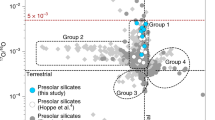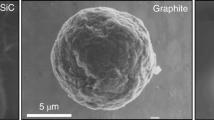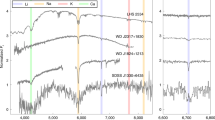Abstract
Primitive chondritic meteorites contain material (presolar grains1), at the level of a few parts per million, that predates the formation of our Solar System. Astronomical observations2 and the chemical composition of the Sun3 both suggest that silicates must have been the dominant solids in the protoplanetary disk from which the planets of the Solar System formed, but no presolar silicates have been identified in chondrites4,5,6. Here we report the in situ discovery of presolar silicate grains 0.1–1 µm in size in the matrices of two primitive carbonaceous chondrites. These grains are highly enriched in 17O (δ17OSMOW > 100–400‰), but have solar silicon isotopic compositions within analytical uncertainties, suggesting an origin in an oxygen-rich red giant or an asymptotic giant branch star7,8. The estimated abundance of these presolar silicates (3–30 parts per million) is higher than reported for other types of presolar grains in meteorites1, consistent with their ubiquity in the early Solar System, but is about two orders of magnitude lower than their abundance in anhydrous interplanetary dust particles9. This result is best explained by the destruction of silicates during high-temperature processing in the solar nebula.
This is a preview of subscription content, access via your institution
Access options
Subscribe to this journal
Receive 51 print issues and online access
$199.00 per year
only $3.90 per issue
Buy this article
- Purchase on Springer Link
- Instant access to full article PDF
Prices may be subject to local taxes which are calculated during checkout



Similar content being viewed by others
References
Nittler, L. R. Presolar stardust in meteorites: recent advances and scientific frontiers. Earth Planet. Sci. Lett. 209, 259–273 (2003)
Waters, L. B. F. M. et al. Mineralogy of oxygen-rich dust shells. Astron. Astrophys. 315, L361–L364 (1996)
Anders, E. & Grevesse, N. Abundances of the elements: meteoritic and solar. Geochim. Cosmochim. Acta 53, 197–214 (1989)
Messenger, S. & Bernatowicz, T. J. Search for presolar silicates in Acfer 094. Meteorit. Planet. Sci. 35, A109 (2000)
Alexander, C. M. O'D., Nittler, L. R. & Tera, F. The search of presolar silicates and the 54Cr carrier. Lunar Planet. Sci. [CD-ROM] XXXII, 2191 (2001)
Mostefaoui, S., Hoppe, P., Marhas, K. K. & Gröner, E. Search for in situ presolar oxygen-rich dust in meteorites. Meteorit. Planet. Sci. 38, A99 (2003)
Nittler, L. R., Alexander, C. M. O'D., Gao, X., Walker, R. M. & Zinner, E. Stellar sapphires: The properties and origins of presolar Al2O3 in meteorites. Astrophys. J. 483, 475–495 (1997)
Lugaro, M., Zinner, E., Gallino, R. & Amari, S. Si isotopic ratios in mainstream presolar SiC grains revisited. Astrophys. J. 527, 369–394 (1999)
Messenger, S., Keller, L. P., Stadermann, F. J., Walker, R. M. & Zinner, E. Samples of stars beyond the solar system: silicate grains in interplanetary dust. Science 300, 105–108 (2003)
Newton, J. et al. Acfer 094, a uniquely primitive carbonaceous chondrite from the Sahara. Meteoritics 30, 47–56 (1995)
Greshake, A. The primitive matrix components of the unique carbonaceous chondrite Acfer 094; a TEM study. Geochim. Cosmochim. Acta 61, 437–452 (1997)
Krot, A. N., Meibom, A., Weisberg, M. K. & Keil, K. The CR chondrite clan: implications for early solar system processes. Meteorit. Planet. Sci. 37, 1451–1490 (2002)
Yurimoto, H., Nagashima, K. & Kunihiro, T. High precision isotope micro-imaging of materials. Appl. Surf. Sci. 203–204, 793–797 (2003)
Kunihiro, T., Nagashima, K. & Yurimoto, H. Microscopic oxygen isotopic homogeneity/heterogeneity in the matrix from the Vigarano CV3 chondrite. Geochim. Cosmochim. Acta (submitted)
Hoppe, P. & Ott, U. in Astrophysical Implications of the Laboratory Study of Presolar Materials (eds Bernatowicz, T. J. & Zinner, E.) 27–58 (AIP Press, New York, 1997)
Huss, G. R., Meshik, A. P., Smith, J. B. & Hohenberg, C. M. Presolar diamond, silicon carbide, and graphite in carbonaceous chondrites: Implications for thermal processing in the solar nebula. Geochim. Cosmochim. Acta 67, 4823–4848 (2003)
Dai, Z. R. et al. Possible in situ formation of meteoritic nanodiamonds in the early Solar System. Nature 418, 157–159 (2002)
Jessberger, E. K. et al. in Interplanetary Dust (eds Grün, E., Gustafson, B. Å. S., Dermott, S. F. & Fechtig, H.) 253–294 (Springer, Berlin, 2001)
Bradley, J. P. & Brownlee, D. E. Cometary particles: thin sectioning and electron beam analysis. Science 231, 1542–1544 (1986)
Hewins, R. H. in Chondrules and the Protoplanetary Disk (eds Hewins, R. H., Jones, R. H. & Scott, E. R. D.) 3–9 (Cambridge Univ. Press, Cambridge, 1996)
Itoh, S. & Yurimoto, H. Contemporaneous formation of chondrules and refractory inclusions in the early Solar System. Nature 423, 728–731 (2003)
Bischoff, A. et al. New carbonaceous and type 3 ordinary chondrites from the Sahara Desert. Meteoritics 26, 318 (1991)
Clayton, R. N. & Mayeda, T. K. Oxygen isotope studies of carbonaceous chondrites. Geochim. Cosmochim. Acta 63, 2089–2104 (1999)
Acknowledgements
We thank E. R. D. Scott for discussions, and I. Takayanagi, K. Kosaka and Suzushin-Kogyo for assistance with SCAPS development. This work was supported by Monkasho (H.Y.) and NASA (A.N.K.).
Author information
Authors and Affiliations
Corresponding author
Ethics declarations
Competing interests
The authors declare that they have no competing financial interests.
Rights and permissions
About this article
Cite this article
Nagashima, K., Krot, A. & Yurimoto, H. Stardust silicates from primitive meteorites. Nature 428, 921–924 (2004). https://doi.org/10.1038/nature02510
Received:
Accepted:
Issue Date:
DOI: https://doi.org/10.1038/nature02510
This article is cited by
-
Dust from supernovae and their progenitors in the solar nebula
Nature Astronomy (2022)
-
Oxygen Isotopes and Sampling of the Solar System
Space Science Reviews (2020)
-
Organogermanium suppresses cell death due to oxidative stress in normal human dermal fibroblasts
Scientific Reports (2019)
-
The Composition of the Protosolar Disk and the Formation Conditions for Comets
Space Science Reviews (2015)
-
Development of an Ultra-High Performance Multi-Turn TOF-SIMS/SNMS System “MULTUM-SIMS/SNMS”
Journal of the American Society for Mass Spectrometry (2013)
Comments
By submitting a comment you agree to abide by our Terms and Community Guidelines. If you find something abusive or that does not comply with our terms or guidelines please flag it as inappropriate.



